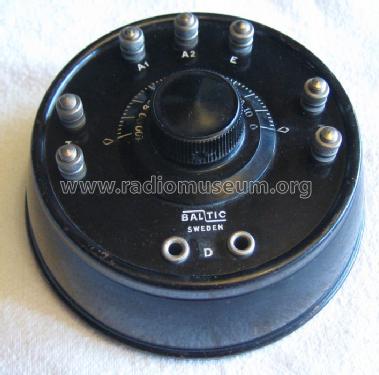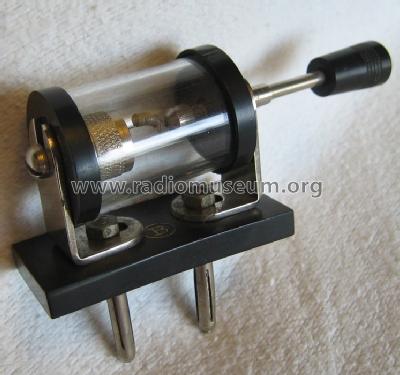Crystal Receiver M2
Baltic; Stockholm
- Land
- Schweden
- Hersteller / Marke
- Baltic; Stockholm
- Jahr
- 1930 ??
- Kategorie
- Detektorempfänger (Kristall oder Diode, ohne Röhre/Transistoren)
- Radiomuseum.org ID
- 85618
- Hauptprinzip
- Detektion ohne aktive Elemente, solid state; Detektor-Primärempfänger
- Anzahl Kreise
- 1 Kreis(e) AM
- Wellenbereiche
- Mittelwelle, keine anderen.
- Betriebsart / Volt
- Keine Stromversorgung
- Lautsprecher
- - Für Kopfhörer oder NF-Verstärker
- Material
- Metallausführung
- von Radiomuseum.org
- Modell: Crystal Receiver M2 - Baltic; Stockholm
- Bemerkung
- Konische Dosenform, Ø unten 120 mm, oben 100 mm. Material: Messingblech. Variometer-Abstimmung.
Es gibt von diesem Modell 3 Ausführungen für 3 Mittelwellenbereiche die sich nur in den Abstimmungs-Induktivitäten unterscheiden.
- Nettogewicht
- 0.3 kg / 0 lb 10.6 oz (0.661 lb)
- Datenherkunft
- - - Data from my own collection
- Autor
- Modellseite von Christian Wirth angelegt. Siehe bei "Änderungsvorschlag" für weitere Mitarbeit.
- Weitere Modelle
-
Hier finden Sie 48 Modelle, davon 26 mit Bildern und 5 mit Schaltbildern.
Alle gelisteten Radios usw. von Baltic; Stockholm
Sammlungen
Das Modell Crystal Receiver befindet sich in den Sammlungen folgender Mitglieder.
Forumsbeiträge zum Modell: Baltic; Stockholm: Crystal Receiver M2
Threads: 1 | Posts: 4
I have a receiver that looks exactly like the M2 although I cannot find any number on it. I have some remarks on this model:
I do not beleive it is as late as 1930. Baltic merged with AGA in the summer 1928 to form AGA-Baltic AB, a receiver marked Baltic would then be made before this. Baltic made advanced valve radios already in 1925-26, so even if they may have produced these crystal receivers in parallell with the valve ones, I believe it is an earlier product, my guess is as early as 1924-25.
My receiver has capacitive tuning, the condenser consisting of two copper plates with glimmer isolation between them, one fixed to the panel and one "spring loaded" that can be pressed against the fixed one by means of a threaded screw on the tuning knob axis. The frequency range is aproximately 270 to 550 kHz, the selectivity is quite bad and of course also the sensitivity as there is no amplification. The receiver would obviously need a strong local station to work reliably.
I enclose photos of my receiver and a wiring diagram.
Anlagen
- Baltic crystal receiver (70 KB)
- Baltic M2 wiring (15 KB)
Bo Samuelsson, 26.Dec.06


